Municipal budgetary educational institution
"Fedorovskaya secondary school No. 5"
Plan - open lesson outline
“POLITICAL SYSTEM IN 20-YY. FIRST DECADES OF SOVIET POWER
ON THE OB-IRTYSH NORTH "

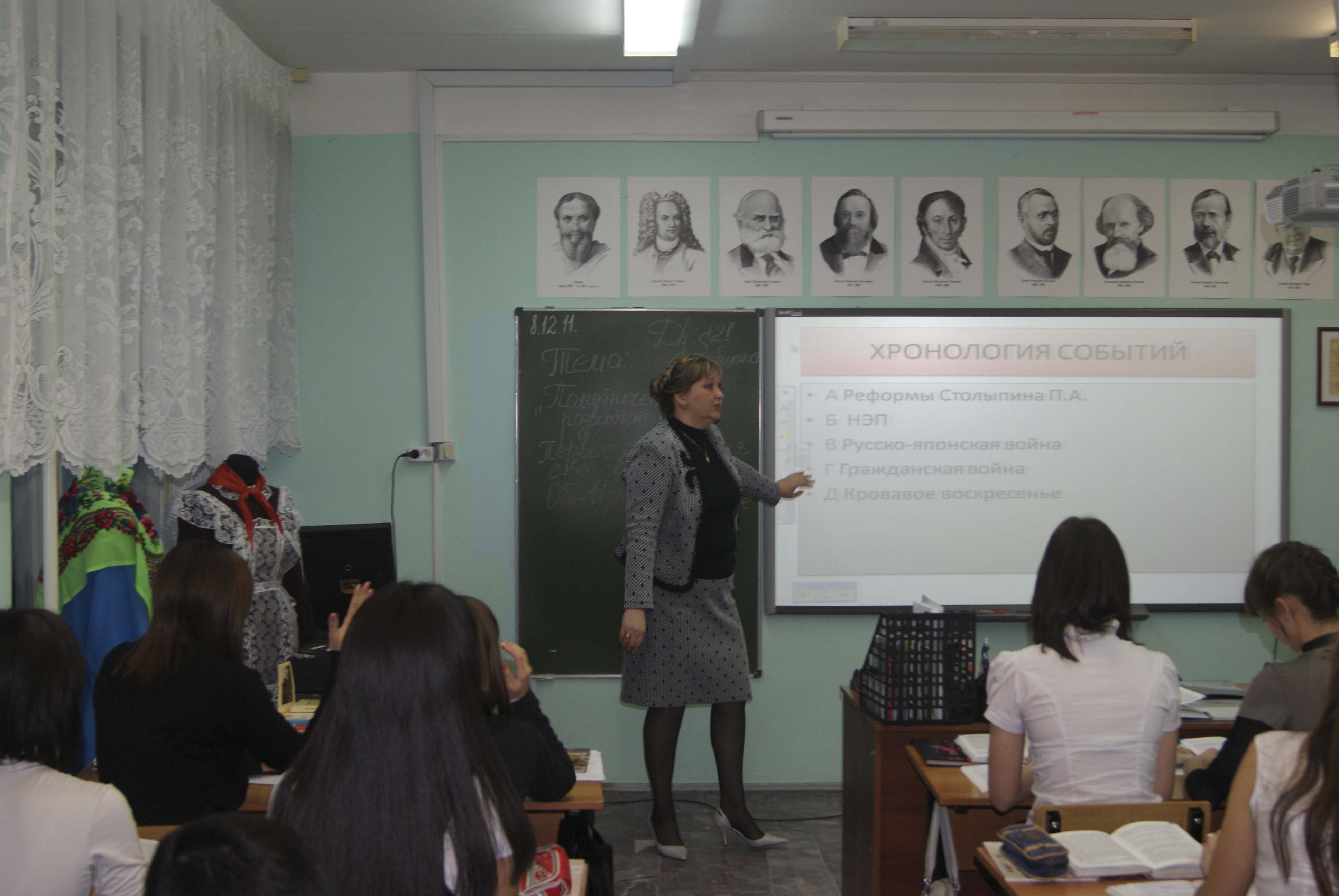
History and Social Science Teacher
Tsatsueva Nadezhda Vladimirovna
urban settlement Fedorovsky
MBOU "Fedorovskaya secondary school No. 5"
Plan - a synopsis of the lesson of the history of Russia 20c.
Theme:“Political development in the 20s. The first decades of Soviet power in the Ob-Irtysh North. "
Target: study the features of the political regime of the USSR in the 1920s. , their influence on the further life of Soviet society, as well as relying on the materials of the school museum, to show their relationship with the history of the Khanty-Mansi Autonomous Okrug.
Tasks:
1. To form students' understanding of the peculiarities of the political regime of the 1920s. on the example of events and facts from the history of the Khanty-Mansi Autonomous Okrug;
2. To lead students to understand the need for a humane approach to the study of issues Civil War and the establishment of Soviet power in the Khanty-Mansi Autonomous Okrug, and in Russia as a whole, in order to preserve the continuity of generations and take into account the historical experience;
3. To continue the ability to give a comparative description of historical events, to work with historical sources and documents, to draw conclusions.
Training equipment:
interactive whiteboard, slide projector, presentations, materials and exhibits of the school museum.
Literature:
Collection of scientific papers "History of Siberia in biographies" Surgut Publishing Center of SURSU 2009.
V.V. Kirilov, M.N. Chernov Lessons methodological developments and scripts of lessons for the course of the history of Russia in the 20th century. A guide for the teacher. Moscow "Center for Humanitarian Education" 2000.
Scientific-methodical journal "Teaching History and Social Science at School" No. 9 2009 Ya.V. Solovyov "Museum pedagogy at the present stage of development of history education"
The history of the Khanty-Mansi Autonomous Okrug from antiquity to the present day. A textbook for the senior classes. Yekaterinburg NPMP "Volot" 1999
Internet resources.
During the classes:
Organizing time.
Updating basic knowledge.
Today in the lesson we will study the topic “Political development in the 20s. The first decades of Soviet power in the Ob-Irtysh North ”.
To study the topic, we need to remember the meaning of the following concepts and terms:
1.intervention-armed interference in the internal affairs of foreign states
2.sovereign m-complete independence of the state from other states 3 war communism-Economic policy of the Bolsheviks during the Civil War
4. rent-use of someone else's property on certain conditions
5.concession- lease to foreign enterprises and persons of industrial enterprises
6 .tax in kind- tax from peasants
7.NEP.
Let's remember chronology of historical events... Task on the board:
TASK №1.
And the reforms of Stolypin P.A.
The Russo-Japanese War
D Civil War
Bloody Sunday
(KEY: WDAGB)
TASK №2.
A Beginning of the First World War
B Adoption of the Constitution of the RSFSR
To the First State Duma
D Formation of the USSR
D Start of NEP (key VABDG)
The study new topic:
Merging of the state and party apparatus. "Dictatorship of the Party". Drawing up a diagram on the board.
(Serious state decisions were made by the Central Committee of the RCP (b) after a preliminary discussion in a close circle of Bolshevik leaders in the Political Bureau (Politburo) of the Central Committee of the RCP (b) created in 1919. ? (Lenin. The post of chairman of the Council of People's Commissars)SCHEME
PARTY RCP (b) GOVERNMENT OF SNK
Politburo (from 1919)
LENIN chairman of the Council of People's Commissars (1918-1924) - (formally did not hold a position in the party, led the plenum)
Secretariat of the Central Committee
Stalin (head of the secretariat)
SECRETARY GENERAL (1922-1953)
Who manages personnel, he controls everything.
The presence of opposition (Shlyapnikov, Klontai, Medvedev)
In connection with the anti-Bolshevik uprising in Kronstadt, the suppression of which was attended by delegates 10 Congress of the RCP (b) 1921, the main idea of the congress was the idea of the unity of the party. Congress adopted resolution "On the unity of the party." Beginning of approval….
Adoption of a one-party political system.
(accusation of aiding the White Guards and interventionists, counter-revolutionary propaganda and agitation);
second stage 1923 Central Committee of the RCP (b) secret "Instruction on measures to combat the Mensheviks"
« Menshevik " negative ideological characterization.
The collapse and actual destruction of the Menshevik party
3. Contradictions of the NEP.
Measures of the NEP? (Students: Freedom of trade and entrepreneurship, rent, concessions, etc.) In the economy, steps towards the market, towards freedom of economic relations, and in politics, on the contrary, the tightening of the regime.
At the end of 1922 and the beginning of 1923. Lenin "Letter to the Congress" containing a political description of Trotsky, Bukharin, Kamenev, Stalin. I did not name the receiver. A special characteristic of Stalin. (More in the topic "Stalin's personality cult)
Stalin against Trotsky... What are the contradictions between Stalin and Trotsky? (Find it yourself in the tutorial pages 158.-159)
Stalin accused Trotsky and his supporters of not believing in the victory of socialism in the USSR "in one separate country."
1924 13 Congress... Trotsky's threat to disintegrate the party. In 1925 the RCP (b) was renamed to the VKP (b)
Outcome: In 1927 Zinoviev were expelled from the party for an attempt to organize a demonstration, Kamenev and Trotsky were exiled to Alma-Ata in 1929.
"Right slope". Why did Stalin win?(ON ONE'S OWN)
Working with the source. (Annex 1)
Creation of a national constituency. Ahead job: at students prepare their own message and presentation Application(under the record on December 10, 1930, the Ostyako-Vogul National District was formed, 1940 was renamed into Khanty-Mansiysk.)
7. A word to the guides.
The head of the department will introduce us to other events in the district. museum.
The first decades of Soviet power in the Ob-Irtysh north. Ideologization of the population - museum (slides and exhibits, music)
The processes that took place in central regions Russia, political, economic, social, did not bypass our district and the Surgut region. There are exhibits in our museum that can tell about the period that you study in history lessons.
In connection with the strengthening of the role of the Communist Party, a massive ideologization of the population began. In 1920. in Surgut, the first organization of the Komsomol was created, in the early 20s. pioneer and October, which developed under the leadership of the Komsomol. In the 30s, the pioneer movement was especially widespread. If in October 1931 there were 1,200 pioneers in the Ostyako-Vogul district, then in April 1938. - almost 4 thousand 700. It should be noted that the pioneer organizations were engaged not only in the class education of children. Together with other schoolchildren, the pioneers worked on collective farms and at enterprises, were engaged in hunting, fishing and picking berries, helped those who were lagging in their studies, and participated in circles.
(exhibits - school uniform, tie, badges, diary of a pioneer counselor, etc.)
(PHOTOS - pioneers, Komsomol members, etc.)
Formation of the mass media. Periodicals played an important role in educating the masses. Soon after the creation of the district, a printing house was opened in Samarov, and on July 7, 1931. the first issue of the newspaper "Khanty-Manchi shop (shoy)" was published. From 1935 it became known as Ostyako-Vogulskaya Pravda.
By 1940. In the district 6 regional newspapers were published in Russian and Khanty languages. It must be borne in mind that all press organs were then under strict party control and were unswervingly pursuing the official line of mobilizing the masses for socialist construction, for the formation of the man of a new society.
(exhibits - "Pionerskaya Pravda", "Komsomolskaya Pravda", books about Lenin, etc.).
Student-tour guide: Soon the Surgut region became one of the places of exile for dispossessed, the so-called "enemies of the people", "kulaks". It was they who made a significant contribution to the 30s. in the development and socio-economic development of the region. The productivity of the work of the special settlers would, of course, be even higher if it were not for the extremely difficult situation in which they found themselves through the fault of the local authorities, who are completely unprepared to accept such a large number of people (more than 1,700 families in the Surgut region alone). The special settlers, who were declared enemies of the people, did not have the bare necessities for the construction of housing in designated, as a rule, uninhabited places, and often died in the very first winter. They were not allowed to move from one place to another. They were to be checked in by the commandant every day. The special settlers were deprived of their civil rights, at the place of residence and work they were isolated from the local population. From the order: “It should be firmly remembered that the special settlers are a socially dangerous element that is under the well-known regime of people deprived of civil and political rights. Treat them as local population it does not follow".
Head of the Museum: So they wrote about people who did not commit any crimes, they were simply evicted as supposedly "class alien elements." The authorities were aware of the dire living conditions, but deliberately did not take any action. Working people were forced to starve, eat surrogates - sawdust, moss, tree rot, fish bones, fish scales, dust, rubbed hay ... People torn, almost barefoot went to work in the severe frost, frostbitten feet. And the authorities wrote that they deliberately "roll around in hospitals instead of working." The special settlers were forbidden to pick berries, mushrooms, cones, etc. in the forest. In many places they were forbidden to fish, they were deprived of medical care, they were mowed down by epidemics of typhus and other diseases. In general, everything was done that contributed to the physical destruction of the special settlers. Despite the injustice committed by the authorities, the special settlers worked in national economy, and during the Great Patriotic War, together with others, they defended the Motherland.
(Exhibits - a samovar, a typewriter, wooden spoons, cup holders, a gramophone).
This is our first lesson meeting, I hope, will develop into a close collaboration. The museum has a wealth of material on recent history Russia, district, Surgut district, village, which can help you in the educational process and extracurricular activities in history. Welcome to our museum, we are waiting for an invitation to the subsequent history lessons.
Let's summarize the lesson:
Reflection. Annex 1. SLIDE (3-5)
Today we got acquainted with the peculiarities of the political regime of the 1920s.
Remember what political events covered in the lesson? (according to the lesson plan)
What new have you learned about the history of the district and the Surgut region? When the county was formed
What is the relationship between events in the country and what is happening in the Ob-Irtysh north?
How do you rate the work ...
Lesson summary: on the board
D Z.p... 21 to learn the material of the lesson, based on the materials of the textbook, independently identify the reasons for Stalin's victory, messages and presentations on the topics: “The Church in the first decades of the Sov. authorities "," Spiritual life in the 20s "
Evaluations
Page 1
Lesson topic: The main directions of the socio-political and state development of the USSR in the years of the twentieth century. The development of the USSR economy at the end of the x years of the twentieth century. Forced modernization.
Lesson plan: 1. Soviet society in the XX century. 2. The formation of the totalitarian system in the USSR in the 20s - 30s. 3. Adoption of the Constitution of the USSR.
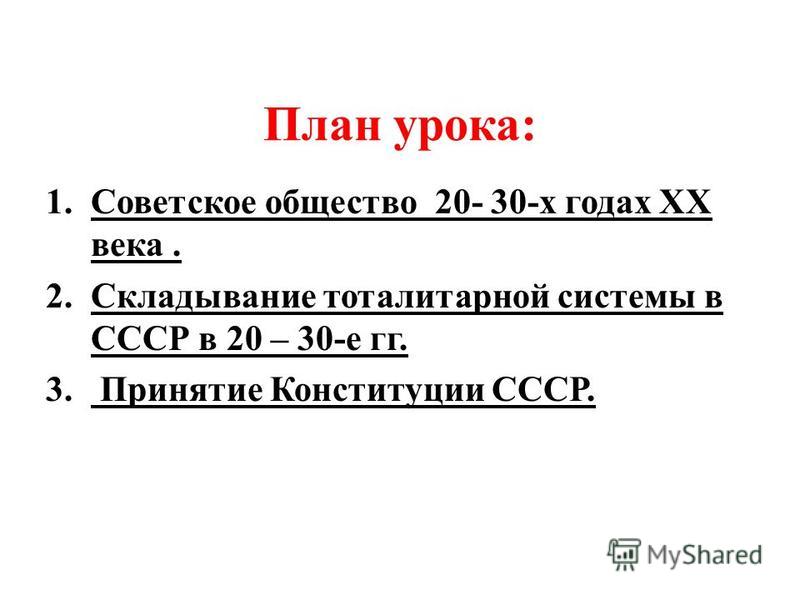
1. Soviet society in the x years of the XX century. The economic transformations of the late 1920s and early 1930s radically changed the structure of the population. 7% of rural residents worked at state agricultural enterprises - in state farms and MTS. Intensive industrial construction led to the birth of new cities. The number of urban population in the years. increased annually by 1.6 million people in years. by 2.04 million. By 1939, there were 56.1 million inhabitants in cities (32.9% of the total population).

The size of the working class increased significantly: from 8.7 million in 1928 to 20.6 million in 1937. Unemployment was eliminated. The main source of replenishment of the working class was the peasants who left the countryside. The influx of yesterday's peasants swelled the ranks of the unskilled work force, which led to staff turnover, a drop in discipline, industrial injuries, the release of defective products, and many negative moral and social consequences. However, part of the skilled workers in connection with the transition to piecework wages achieved high indicators in the results of their work.
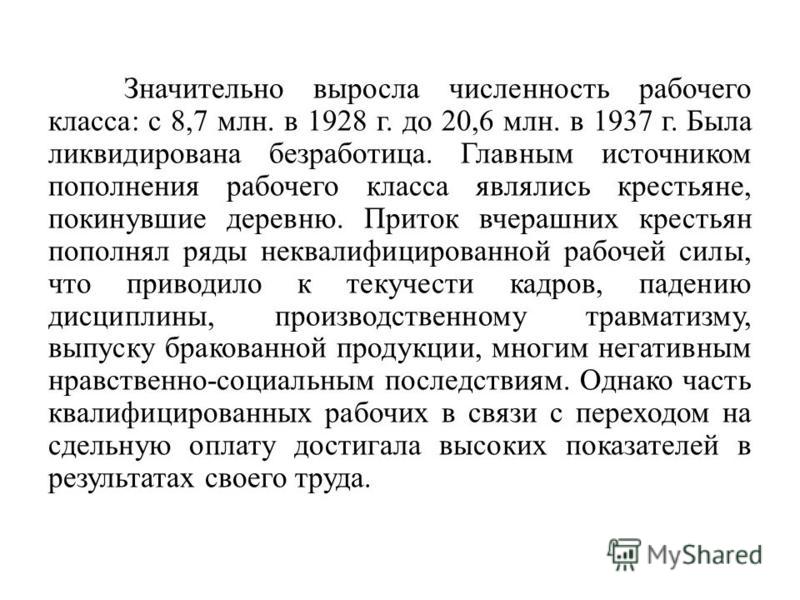
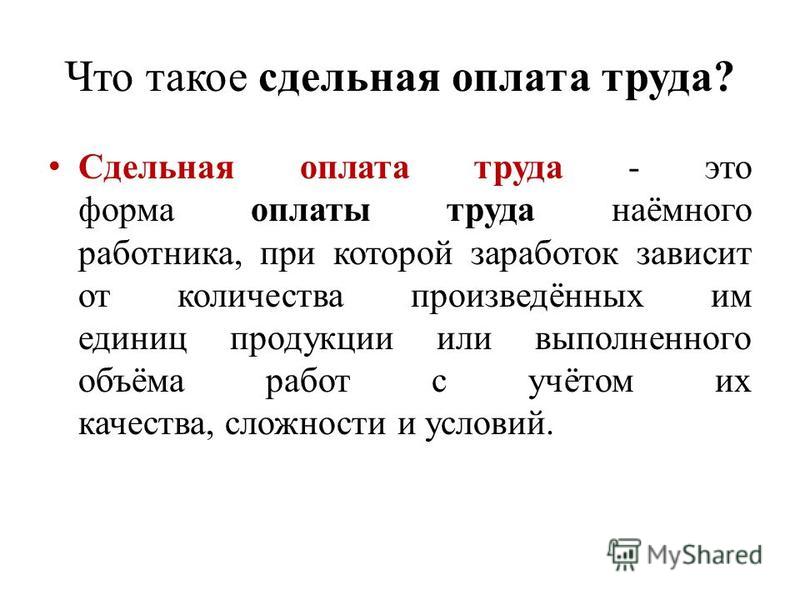
The structure of the rural population has changed. The number of peasants decreased several times. Over 90% of the total number of peasants worked on collective farms. They constituted a new social category of the population ("collectivist peasants", a class of collective farm peasantry).

During the years passed: collectivization of agriculture and industrialization Collectivization is the process of uniting peasant farms into collective farms (collective farms in the USSR). The decision on collectivization was made at the 15th Congress of the All-Union Communist Party of Bolsheviks in 1927. Held in the USSR in the late 1920s and early 1930s (); in the western regions of Ukraine, Belarus and Moldova, in Estonia, Latvia and Lithuania collectivization was completed in the years.
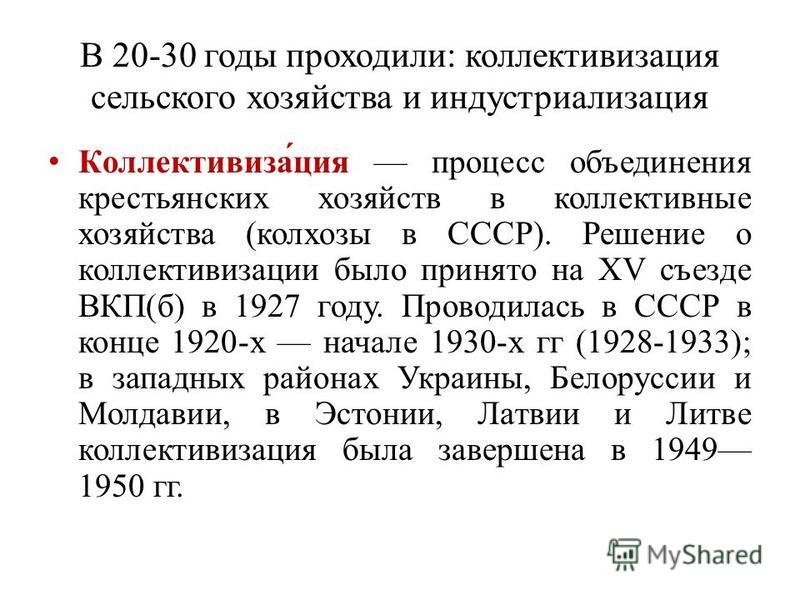
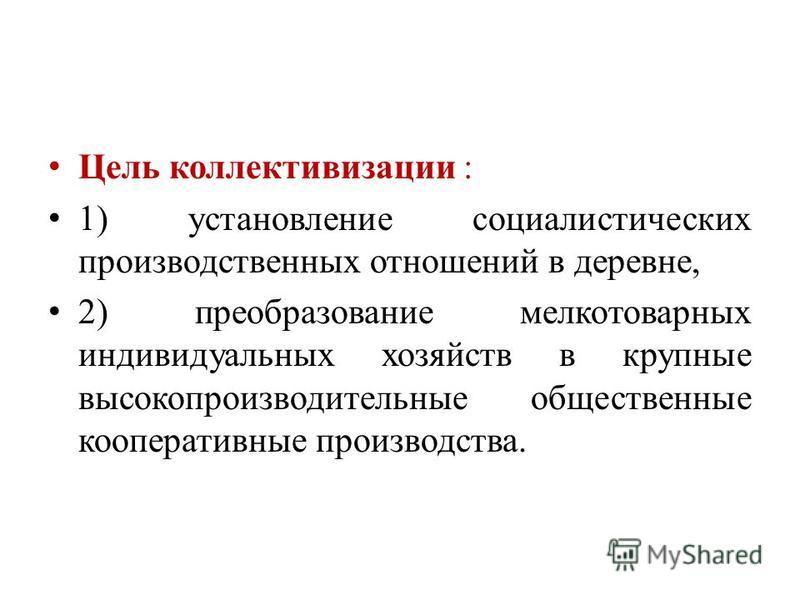
![]()
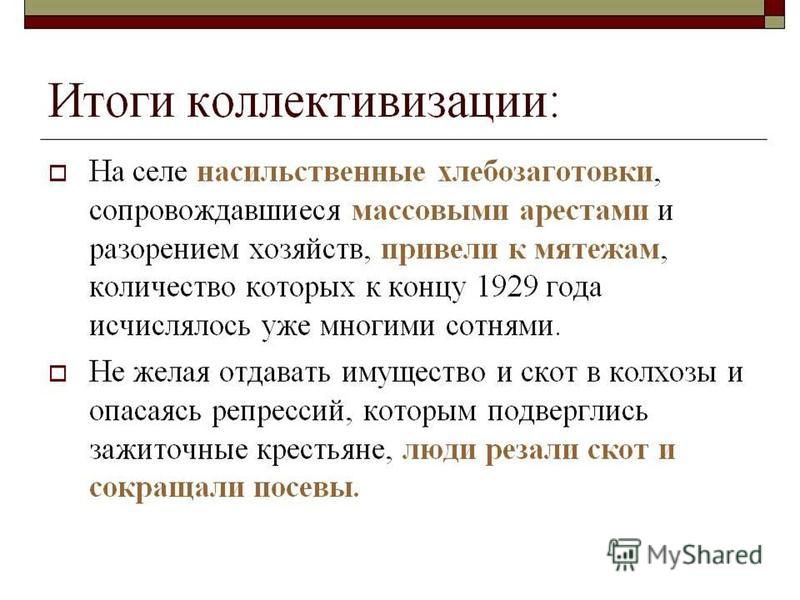
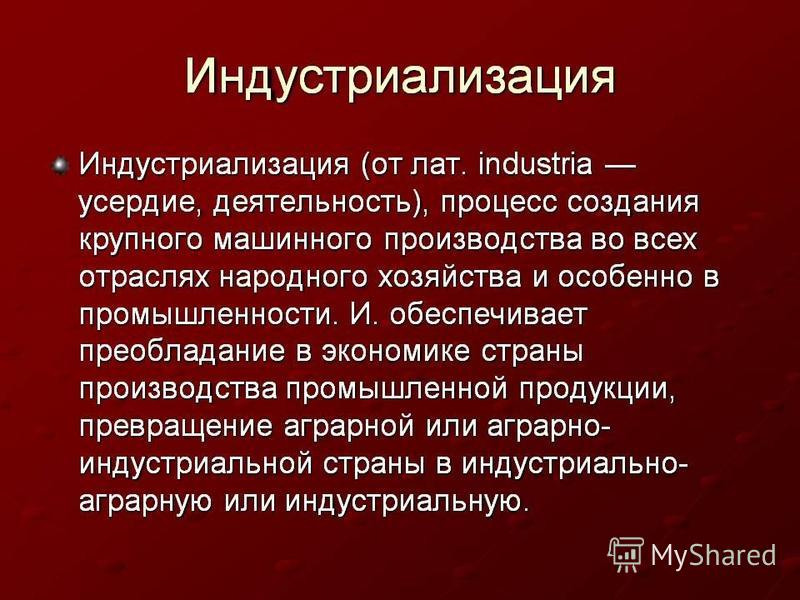
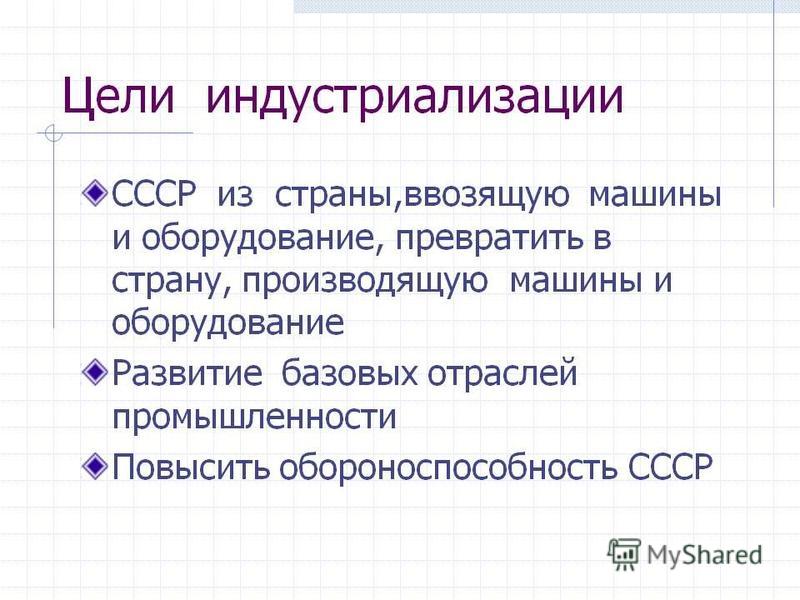
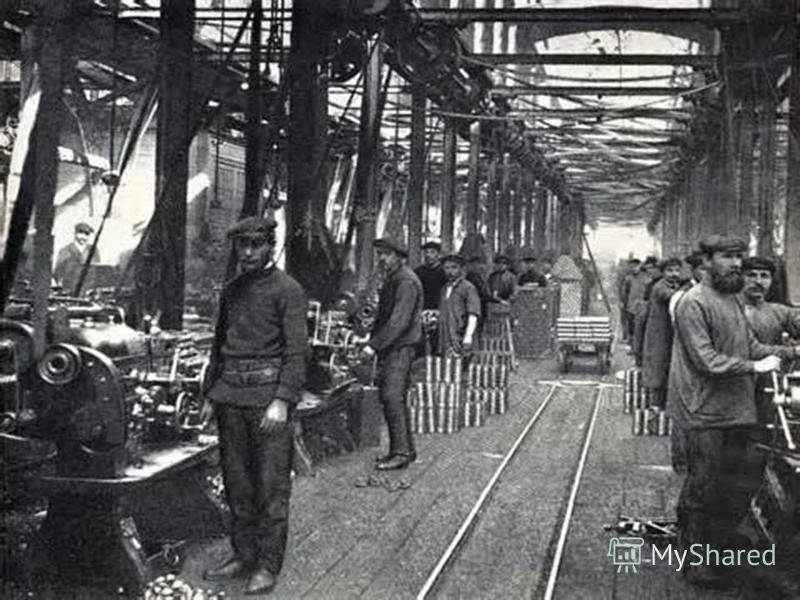
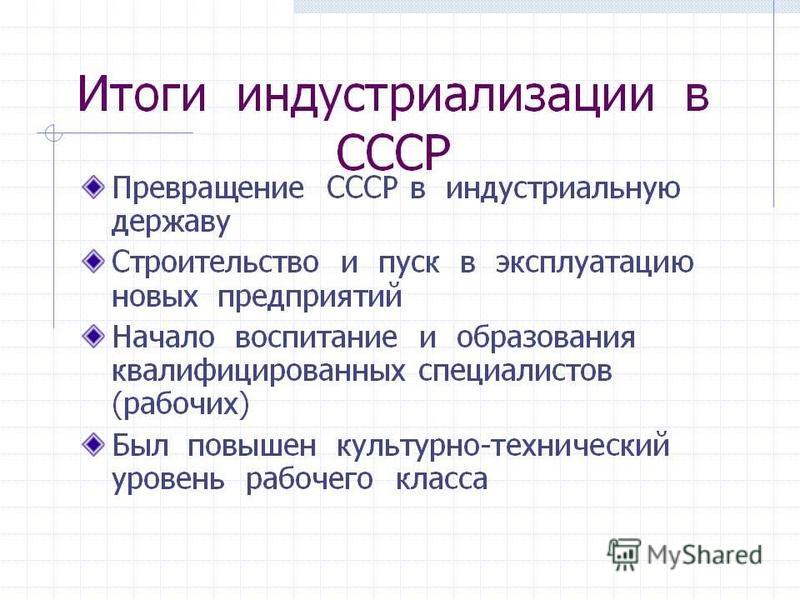
2. The folding of the totalitarian system in the USSR in the 20s - 30s. In the 20s. the formation of a one-party system was completed. Monarchist and liberal parties were liquidated in the first years after the October Revolution of 1917. Internal party struggles in the 1920s. ended with the personal victory of Stalin, who by 1929 seized absolute power in the party and state. A course was taken towards industrialization, collectivization of agriculture, and the establishment of a command economy.
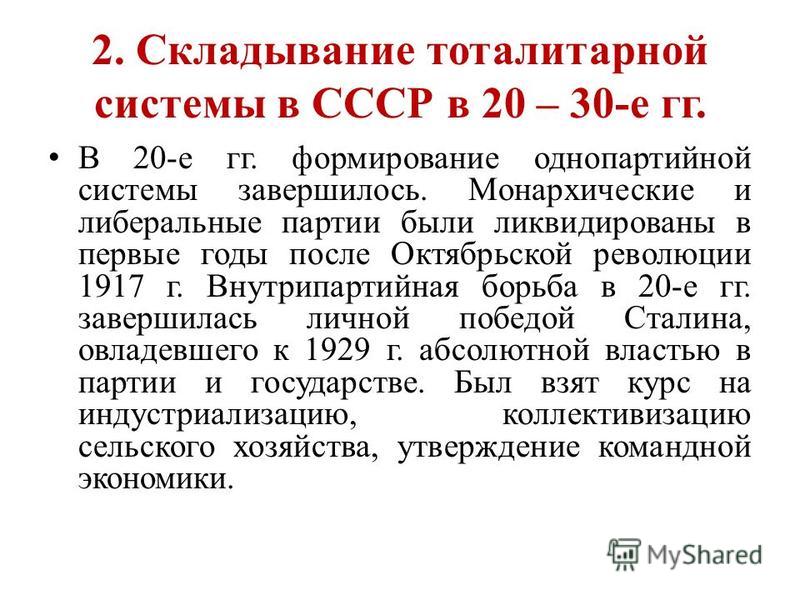

What is totalitarianism? they call a society in which 1) the multi-party system has been eliminated and a one-party political system exists; 2) the ruling party merged with the state apparatus and subordinated it to itself; 3) a single, universally binding ideology has been established; 4) there is no society independent of the control of the party and the state.
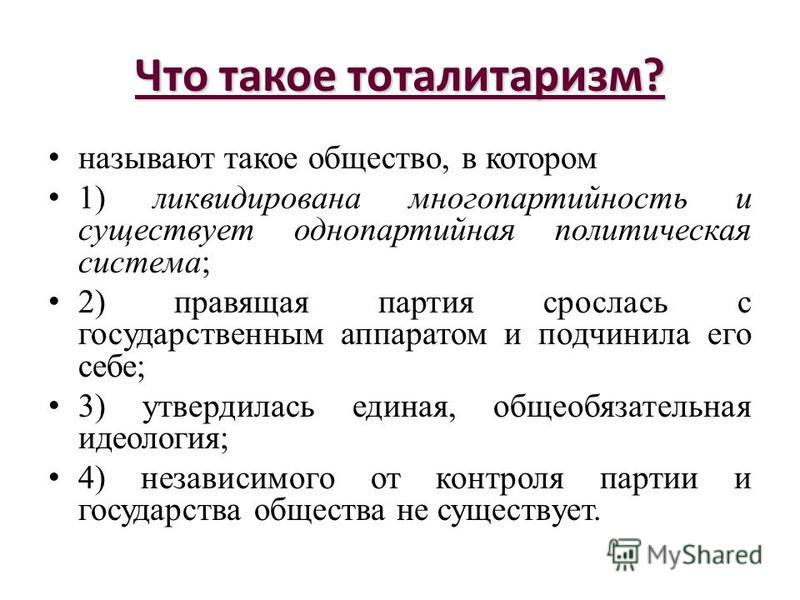
5) all public organizations and all public relations are directly controlled by the state; 6) the cult of the leader has developed; 7) there is an extensive police apparatus conducting reprisals against citizens; eight) civil rights formally recognized, in fact, liquidated.
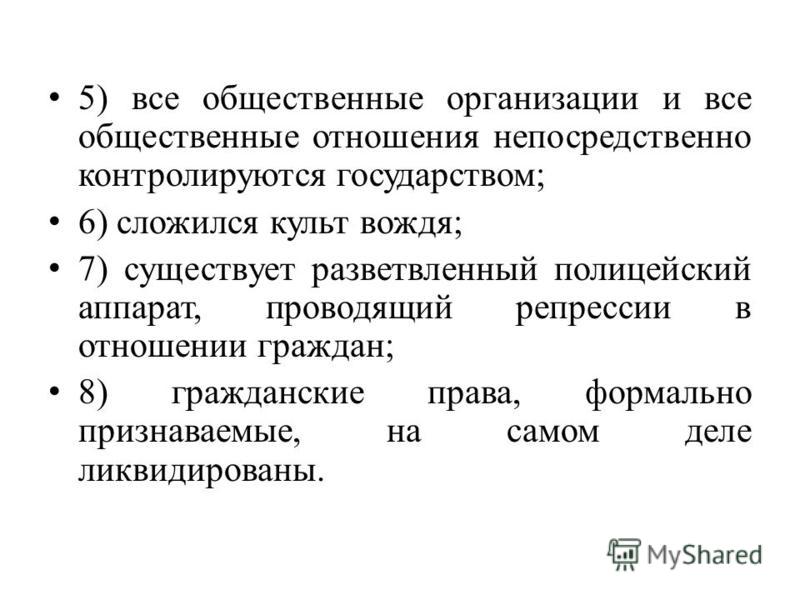
Signs of totalitarianism: the forcible imposition of public orders on citizens that affirm a single ideology; total control over all spheres of society; political monopoly of one party; ideological sterility and elimination of opposition; the presence of an ideological leader; the presence of physical systems, socio-economic and psychological intimidation; mass terror;
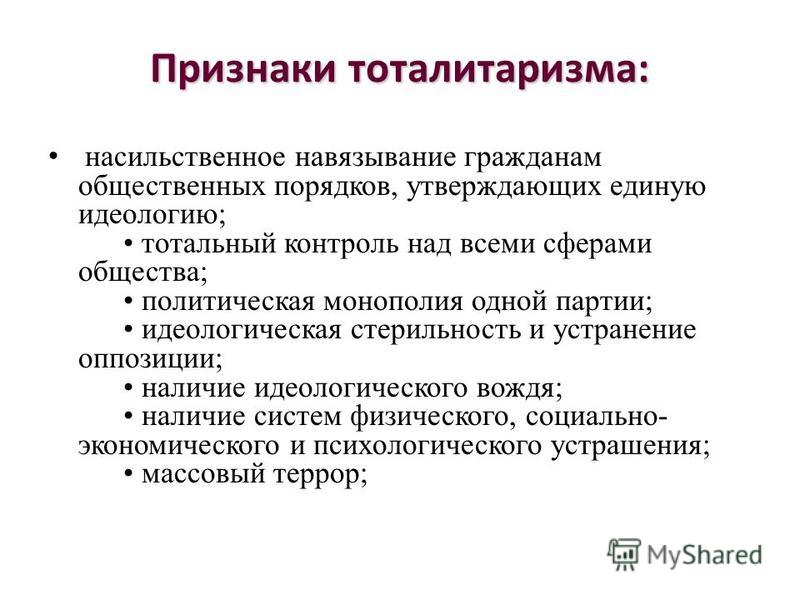
"Political fragmentation" - Veche - National Assembly. The control system of the Novgorod Republic. Appointed officials. Political fragmentation in Russia (XII - early XIII centuries). Map "Political fragmentation of Russia in XII - early XIII". Assignment: list the specific principalities of Russia. Expansion of the agricultural economy.
"Man in the political system" - Conflict - the opposition of the interests of the government and the person. Artificially homogeneous. Activist (the state and citizens act as equal political partners). It is carried out through both political and non-political agents of socialization. In the sphere of behavior. Mobilization - organizes citizens to solve certain social and political problems.
"Stalin's political system" - What features were most characteristic of the political system of the USSR in the 30s? Constitution of victorious socialism December 5, 1936. The political system of Stalinism. Political Processes 1936-1938. Constitution of victorious socialism 1936. Totalitarianism. By the beginning of the 30s. the totalitarian regime has become a harsh political reality.
"The political system of society" - Ideas. Prejudice. Control. Ideological subsystem. Entrance. Democratic (constitutional). Versatility. POLITICAL SYSTEM OF SOCIETY (structural-functional approach). Traditions. Constitution. Economic basis. Solutions. Continental European. The attitude of party power, government.
"Change of the political system" - Changes in political system Russian Empire... Emperor until October 17, 1905. After October 17, 1905, the emperor. Changes in the political system. Electoral law of Russia: place symbols on the diagram. Features of the Russian multiparty system. Fill in the table.
"A political map of the World" - Political geography... Change of formations, the conquest of sovereignty, the introduction of a new one state structure... Most countries in Africa as well as Asia and Latin America... Social level - economic development... Territorial gains, losses, voluntary concessions. 2. Monarchies. 3. States within the Commonwealth.
- 1 –The lesson was developed by a history teacher of the first category
MBOU "School No. 29", Norilsk, Krasnoyarsk Territory
Polenok Tatiana Mikhailovna
The lesson was developed according to the course "History of Russia" for grade 9
Lesson "Political Development in the 1920s."
The purpose of the lesson: to bring students to an understanding of the changes that have occurred in the political
sphere of the state in the 1920s, to reveal the causes and results of the internal party
fight.
Lesson type: combined (teacher's lecture combined with independent work
students in groups and individually with the text of the textbook, documents,
table, performance of problematic tasks, student performances on
preliminary assignments, filling out the table, conducting a discussion)
Lesson equipment: textbook § 21 "History of Russia XX - early XXI century"
A. A. Danilov, L. G. Kosulina, M. Yu. Brandt.
Reader on the history of Russia in the twentieth century
Table "Leaders of the party and state in the 20s."
Table "Struggle for power in the Bolshevik Party"
Lesson plan
1.Fusion of the state and party apparatus
2. Establishment of a one-party political system
3 internal party power struggles
During the classes
1.Fusion of the state and party apparatus.
The study of this issue begins with the formulation of a problematic task to the class, followed by the teacher's lectures, the disclosure of the concept of "political system", the work of students with the text of the textbook, a table, the work on the issue is completed with the conclusions of the students.
Teacher
Assignment to the class The political system formed during the Civil War at the XII Congress
RCP (b) was called "the dictatorship of the party"
Why did the Congress come to this conclusion?
Teacher
What do we mean by "political system"?
The political system is a set of institutions (i.e. bodies, organizations) that carry out political functions. In the 1920s, the individual links of the political system were: the Soviet state, the Bolshevik party, public organizations, among which the most massive are the Komsomol and trade unions. It was believed that all bodies and organizations are involved in government. But was it really so?
Students work with the text of the textbook and the proposed table.
Assignment to students. Based on the text of the textbook (§21, p. 155), study the composition of the Politburo, recall the most active party leaders and get acquainted with the contents of the table.
What conclusion can be drawn from these data?
2 -
table
Party and state leaders in the 1920s
Chairpersons
All-Russian Central Executive Committee of the RSFSR and
Central Executive Committee of the USSR Heads
SNK RSFSR
and the USSR Leaders
organs
security
(VChK - OGPU - NKVD) Leaders
armed
forces
Kamenev L.B.
October-November 1917
Sverdlov Ya.M.
1917-1919
Kalinin M.I.
1919-1946 Lenin V.I.
1917-1924
Rykov A.I.
1924-1930
V.M. Molotov
1930-1941
Stalin I.V.
1941-1953 Dzerzhinsky F.E.
1917-1926
Menzhinsky V.R.
1926-1934
Yagoda G.G.
1934-1936
Ezhov N.I.
1936-1938
Beria L.P.
1938-1941 Trotsky L.D.
1918-1925
Frunze M.V.
January-October
1925 g.
Voroshilov K.E.
1925-1940
Timoshenko S.K.
1940-1941
Stalin I.V.
1941-1947
Teacher (summarizes what students said)
The main positions in the political system in the 1920s were occupied by the RCP (b) (since 1925 - VKP (b)). The RCP (b) actually performed the functions of state bodies. Political decisions were taken first by the Central Committee of the party, and then they were consolidated in the decisions of the Soviets. State bodies were also led by party leaders. The party carried out "selection and placement of personnel."
Students formulate an answer to the task assigned to the class
In the USSR, a totalitarian state is being formed, the most important features of which are the merging of the party and state apparatus and the monopoly of the political party on power. Having concentrated state and party power in its hands, the RCP (b) established full control over the political system, which is why at the XII Congress of the RCP (b) it was called the dictatorship of the party
2. Adoption of a one-party political system.
This issue is studied by combining the teacher's story, students' independent work with documents, students are heard presentations on preliminary assignments
Student work with documents
Document
From V. I. Lenin's opening speech at the X Congress of the RCP (b)
… ..We have experienced an exceptional year, we allowed ourselves the luxury of discussions and disputes within our party. For a party that is surrounded by enemies, the most powerful, strongest enemies that unite the entire capitalist world, for a party that bears an unheard-of burden, this luxury was truly amazing!
Questions to the document
Against whom is Lenin's speech directed?
Why does he call discussions in the party a luxury?
What dangers inevitably arise in this case?
Document
From the resolution of the X Congress of the RCP (b) "On the unity of the party"
.... The congress prescribes the immediate dissolution of all groups formed on this or that platform, without withdrawal, and instructs all organizations to strictly monitor the prevention of any factional actions. Failure to comply with this resolution of the Congress should lead to unconditional expulsion from the Party.
Questions to the document
What issue was raised in the resolution?
What measures should be taken towards people who have created or joined the opposition in the RCP (b)?
What are the benefits of banning factions for a party?
Teacher (summarizes student responses)
The adoption by the congress of the resolution "On Party Unity" prohibiting the creation in the RCP (b) of factions and groups with a point of view different from the party leadership, opened up the possibility of reprisals against people disliked by the party leadership and strengthening the party from within. The difficult economic and political situation in the country by the beginning of the 20s, demanded the destruction of any manifestation and external ideological and political opposition. To this end, the RCP (b) begins a decisive struggle against the Socialist-Revolutionaries and Mensheviks.
Students (students hear messages on advance assignments)
Material for the student's message: "The struggle of the Bolsheviks against the political opposition - the parties of the Mensheviks and Socialist-Revolutionaries"
After the dispersal of the Constituent Assembly until the summer of 1918, the Menshevik and Socialist-Revolutionary parties were legal: their newspapers were published, and local party committees nominated candidates for elections to local Soviets, trade union, cooperative organizations, etc. But the press was gradually closed, and where the Socialist-Revolutionaries and Mensheviks won the elections to the Soviets, the election results were declared invalid (as it was in Tambov in the spring of 1918). The Left Socialist-Revolutionary coalition disintegrated, and a "Left Opposition" appeared in the ranks of the Bolsheviks. But the Mensheviks and Socialist-Revolutionaries failed to find an ally in the person of the Left Socialist-Revolutionaries or "Left Communists".
In May 1918, the Socialist-Revolutionary squads took part in the performance of the Czechoslovak corps, and the authority of the Committee of Members of the Constituent Assembly (Komuch) was proclaimed in Samara. By a resolution of the All-Russian Central Executive Committee of June 14, 1918, the Socialist-Revolutionaries and Mensheviks were accused of organizing armed uprisings against the workers and
peasants, and it was proposed to remove them from the Soviets. The elections to the V All-Russian Congress of Soviets were to be held without the participation of Mensheviks and Socialist-Revolutionaries.
Representatives of Komuch in September 1918 participated in the creation of the Directory on the territory liberated from Bolshevism. On November 18, 1918, Kolchak overthrew the Directory, establishing a military dictatorship. Finding themselves in 1918 between two dictatorships - the Bolsheviks and the Whites - the Mensheviks and Socialist-Revolutionaries were forced to choose the lesser of two evils and, in the circumstances, preferred to cooperate with the Reds. The Menshevik Party was legalized in November 1918, the Socialist-Revolutionary Party in February 1919. Despite this, these parties did not become full-fledged political organizations.
The leaders of the Mensheviks and Socialist-Revolutionaries used the tribunes of the 7th and 8th All-Russian Congress of Soviets to criticize the policy of "war communism". Strikes in Petrograd, demonstrations in Kronstadt, the Tambov uprising, unrest in the Don, Kuban, Siberia showed that the rebels spontaneously repeat the political slogans of the Mensheviks and Socialist-Revolutionaries. The Bolsheviks declared every anti-Bolshevik uprising anti-Soviet, although the rebels did not oppose the Soviets. Thus, at the beginning of 1921, the Bolsheviks again went over to a merciless struggle against the Mensheviks and Socialist-Revolutionaries, without abandoning their program of economic revival of the country. The Socialist-Revolutionaries, in turn, took an active part in the armed opposition to Bolshevism.
Trying to explain the repression against the socialist parties, the Bolsheviks held open trials, the most famous of which was the June-August 1922 trial in Moscow. The leaders of the Socialist-Revolutionary Party were accused of organizing conspiracies to overthrow Soviet power, of complicity
White Guards and foreign interventionists, in counterrevolutionary propaganda and agitation. The Supreme Tribunal of the All-Russian Central Executive Committee sentenced the accused to death, but suspended the execution of the sentence. The convicts became political hostages to warn the Social Revolutionaries who remained at large from speaking out against the authorities.
In June 1923, the Central Committee of the RCP (b) developed a secret instruction "On measures to combat the Mensheviks", which set the task of crushing the Menshevik party. During 1923, the Mensheviks and Socialist-Revolutionaries, suspected of illegal political activity, were subjected to systematic repressions.
The best outcome for the repressed was emigration, but it extended only to the most famous personalities opposition parties. Those who did not show remorse were doomed to exile to Siberia or to special camps - Arkhangelsk, Kholmogorsk, Pertominsky. In the summer of 1923, these prisoners were sent to Solovki.
Material for the student's message on the topic: "The fate of the party of the Left SRs"
The Left SR faction was formed at the III Congress of the AKP in May 1917. In all subsequent events, including the preparation and conduct of the October Revolution, the Left SRs collaborated with the Bolsheviks. On November 19, in Petrograd, a constituent congress of the party of the Left Social Revolutionaries met, which confirmed the course of a coalition with the Bolsheviks, including on the question of the Constituent Assembly. At the Second Congress of Soviets, the Left Social Revolutionaries became part of the All-Russian Central Executive Committee; acting as an opposition party, they used the tactics of inquiries into the SNK. On November 18, 1917, the PLSR decided to join the SNK, heading six people's commissariats. Cooperation between the parties continued until the ratification of the Brest Treaty. The PLSR left the SNK, but remained in the All-Russian Central Executive Committee, the collegiums of the people's commissariats, and other institutions. In the late spring of 1918, the Socialist-Revolutionaries actively opposed the decrees "On the Food Dictatorship" and "On the Committees of the Poor." They also protested against the decision of the All-Russian Central Executive Committee of June 14, 1918. The PLSR leaders believed that the Bolsheviks' policy was explained by their orientation towards Germany. On June 24, the Central Committee of the Left Social Revolutionary Party decided to undertake a series of terrorist acts against the most prominent representatives of German imperialism.
At the V Congress of Soviets, after the first meeting, it became clear that the Bolsheviks did not intend to revise the political line. Then the Central Committee of the PLSR decides to assassinate the German ambassador, Count Mirbach. This was, according to their plan, to persuade Germany to break the peace treaty. The consequences of this event were completely opposite. The July 6 rally not only led to the arrest of prominent representatives of the party, but also split the party. The most intransigent part of it did not change its attitude towards the policy of the Bolsheviks.
In the summer of 1919, the PLSR Central Committee rejected the methods of armed struggle against the Soviet regime. However, not all party members agreed with this. In 1920, an independent center was formed, which did not obey the majority. But on the whole, the ranks of the party were noticeably thinning. The last conference of the Left SRs in June 1922 was attended by 23 delegates. By the end of 1922, the collapse of the organization became a fact. Some of its leaders went to the Bolsheviks, others were in exile and prisons, and others in exile. The party has completely lost the support of the people.
Teacher
With the defeat of the Menshevik and Socialist-Revolutionary parties, the political opposition outside the Bolshevik Party ceased to exist. A one-party political system was established in the country.
3. Internal party power struggle.
To study this issue, after the teacher's introductory words, the class is divided into four groups, each group receives an assignment, after the performance of each group, a table is drawn up.
5 –
Teacher
In mid-December 1922, Lenin's health condition deteriorated sharply. Concerned about the fate of the party, Lenin in late 1922 - early 1923 dictated a "Letter to the Congress", known as "Testament" of Lenin, where he characterized the political and personal qualities of six prominent party leaders: Stalin, Trotsky, Kamenev, Zinoviev, Bukharin and Pyatakov and warned of possible conflicts between Trotsky and Stalin, which could lead to a split in the party. Noting that Stalin concentrated enormous power in his hands, Lenin expressed doubt whether Stalin, due to his negative character traits, would always be able to carefully use it as General Secretary. Lenin proposed to remove Stalin from the post of General Secretary of the Central Committee of the RCP (b). After Lenin's death, an acute struggle for power broke out in the party leadership. The 13th Party Congress decided to leave Stalin as General Secretary, as he promised to correct shortcomings in his character.
After the end of the Civil War, the RCP (b) had to solve complex political and economic problems, in the solution of which different points of view arose in the leadership of the party, opposition groups were formed.
Exercise
Determine the reasons for the formation of opposition groups in the party, the essence of their disagreements (the work of students in groups with the text of the textbook)
Group 1 considers the reasons for the formation of the "workers' opposition" (§21 p. 155, item 1)
Group 2 considers the reasons for the confrontation between Stalin and Trotsky (§21 p. 158, item 4)
Group 3 considers the reasons for the formation of a "new opposition" (§21 p.159, paragraph 4)
Group 4 considers the reasons for the formation of the "right opposition" (§21 p.160, paragraph 5)
The conclusions of each group are recorded by all students in a table
Years Opponents The essence of the disagreement
1921 "Workers' opposition"
Shaposhnikov A.G. Stalin I.V.
Kollontai A.M. and his supporters
S.P. Medvedev The "Workers' Opposition" opposed the party's interference in all spheres of society and the state (the party should engage in agitation and propaganda, the Soviets - the state)
At the 10th Party Congress, a resolution "On Party Unity" was adopted, the views of the "workers' opposition" were condemned.
1923-1924
Trotsky L.D. Stalin I.V.
and his supporters and his supporters
... Trotsky L.D. - criticized the division of the party into professional party functionaries, elected from above, and the party masses that do not participate in party life.
Trotsky L.D. believed that without a world revolution, the building of socialism in the USSR is impossible.
Stalin I.V. accused Trotsky of L.D. and his supporters that they do not believe in the possibility of building socialism in the USSR, anti-Leninism, in undermining the unity of the party.
1926 g.
"New opposition"
Kamenev L.B. Stalin I.V.
Zinoviev G.E. Bukharin N.I.
"New opposition" - opposed the course of Bukharin N.I. in agriculture
(land lease, employment of hired labor, tax breaks, enrichment course) called "village NEP"
Stalin I.V. supported Bukharin N.I.
1927 g.
"Right opposition"
Bukharin N.I. Stalin I.V.
Rykov A.I. and his supporters
Tomskiy M.P. Political divisions arose in connection with the grain procurement crisis.
The "Right Opposition" believed that the causes of the crisis were the mistakes of the party leadership
Stalin I.V. and his supporters considered the causes of the crisis to be a violation of economic proportions. Stalin proposed that all resources be devoted to industrialization and the reorganization of agriculture, accelerating the creation of large collective farms.
Stalin accused Bukharin and all his supporters of a "right deviation" incompatible with being in the party
Teacher
By the end of the 20s. opposition groups were defeated by Stalin, and the participants were removed from the party, some were expelled from the USSR as "enemies of the people and spies of foreign states."
Some historians believe that there was a political upheaval in 1929. It was not accompanied by a change in the forms of power, there were no violent events. Simply, the composition of the party leadership changed dramatically, political opponents of Stalin were removed from the Politburo, personnel changes began in the Center and in the localities; finally, only Stalin's supporters remained in the Politburo, who recognized him as the only leader of the party.
4.Why J.V. Stalin won in the struggle for power
Teacher
Question to the class
Was the internal party disagreement a dispute over the ways of the country's further development, or was it a struggle for power?
Teacher (summarizes the students' presentations)
In the period from 1923 to 1928. in the Bolshevik party, a struggle for power unfolded between Trotsky, Zinoviev, Kamenev, Bukharin and Stalin. In 1929, J.V. Stalin won the inner-party struggle. His main opponents - Trotsky, Zinoviev, Kamenev and Bukharin - were removed from the leading party posts.
Possessing outstanding organizational skills, he managed to achieve the promotion to key posts in the center and in the field of his comrades-in-arms in the revolutionary past - V.M. Molotov, S.M. Kirov, L.M. Kaganovich, G.K. Orzhonikidze and others.
The General Secretary of the Central Committee carried out insidious tactics towards his opponents. Knowing very well their weaknesses, rivalry with each other, he separated them, provoked conflicts and disputes between them on theoretical issues, in which he himself initially did not participate. So, in the fight against Trotsky, the main role in 1923-1925. played by Zinoviev and Kamenev. In turn, Bukharin was the most active in refuting their views.
JV Stalin and his entourage took advantage of the fact that the meaning of theoretical discussions was poorly understood by most members of the CPSU (b), accustomed to simple and clear slogans. It turned out to be easy for ordinary party members to convince that the "theoreticians" who imposed the VKP (b) discussions are in fact carrying out splitting activities and should be fought against.
7 –
Gradually, the majority of party members began to perceive Stalin as a defender of the unity of the party, an implacable fighter against all kinds of "deviators."
Stalin put forward a thesis that became fundamental to his entire policy: as the country moves towards socialism, the class struggle will inevitably intensify. The thesis, convenient in that it easily explained why the old revolutionaries became enemies, led to the idea of the need to rally around the leader.
The lesson ends with a generalization of the material studied.
Questions for students
What changes have occurred in the country's political system in the 1920s? What value did they have for further political development country?
Homework
§ 21, questions and tasks p. 162




